
Beltsville is a census-designated place (CDP) in northern Prince George's County, Maryland, United States. The community was named for Truman Belt, a local landowner. The 2020 census counted 20,133 residents. Beltsville includes the unincorporated community of Vansville.
Muirkirk is an unincorporated community in northern Prince George's County, Maryland, United States, located between Baltimore and Washington in the central part of the state.
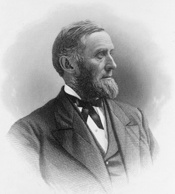
Charles Edward Coffin, was an American industrialist and Republican politician who moved to Maryland during the American Civil War to operate ironworks near the national capital, and later served in both houses of the Maryland legislature as well as the United States House of Representatives.

The Ammendale Normal Institute is a U.S. historic location in Beltsville, Maryland. Bought in 1880, it was a school and novitiate operated by the Institute of the Brothers of the Christian Schools. The Ammendale area is named after the previous owner, Daniel Ammen.

The William Paca House is an 18th-century Georgian mansion in Annapolis, Maryland, United States. Founding Father William Paca was a signatory of the Declaration of Independence and a three-term Governor of Maryland. The house was built between 1763 and 1765 and its architecture was largely designed by Paca himself. The 2-acre (8,100 m2) walled garden, which includes a two-story summer house, has been restored to its original state.
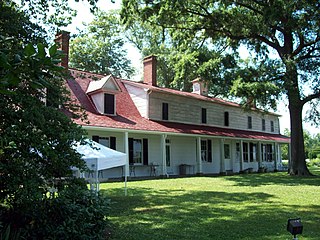
Sotterley Plantation is a historic landmark plantation house located at 44300 Sotterley Lane in Hollywood, St. Mary's County, Maryland, USA. It is a long 1+1⁄2-story, nine-bay frame building, covered with wide, beaded clapboard siding and wood shingle roof, overlooking the Patuxent River. Also on the property are a sawn-log slave quarters of c. 1830, an 18th-century brick warehouse, and an early-19th-century brick meat house. Farm buildings include an early-19th-century corn crib and an array of barns and work buildings from the early 20th century. Opened to the public in 1961, it was once the home of George Plater (1735–1792), the sixth Governor of Maryland, and Herbert L. Satterlee (1863–1947), a New York business lawyer and son-in-law of J.P. Morgan.

The Greenbelt Historic District is a national historic district located in Greenbelt, Prince George's County, Maryland, United States. The district preserves the center of one of the few examples of the Garden city movement in the United States. With its sister cities of Greenhills, Ohio and Greendale, Wisconsin, Greenbelt was intended to be a "new town" that would start with a clean slate to do away with problems of urbanism in favor of a suburban ideal. Along with the never-commenced town of Greenbrook, New Jersey, the new towns were part of the New Deal public works programs.

Snow Hill is a manor house located south of Laurel, Maryland, off Maryland Route 197, in Prince George's County. Built between 1799 and 1801, the 1+1⁄2-story brick house is rectangular, with a gambrel roof, interior end chimneys, and shed dormers. It has a center entrance with transom and a small gabled porch. A central hall plan was used, with elaborate interior and corner cupboards. The original south wing was removed and rebuilt, and the home restored in 1940. The Late Georgian style house was the home of Samuel Snowden, part owner of extensive family ironworks, inherited from his father Richard Snowden. and is now owned and operated by the Maryland-National Capital Park and Planning Commission as a rental facility.

St. Ignatius Church is a Catholic church of the Archdiocese of Washington located at 2315 Brinkley Rd., Fort Washington, MD 20744, in Oxon Hill, Prince George's County, Maryland.

The George Washington House, or Indian Queen Tavern, is located at Baltimore Avenue, at Upshur Street, in Bladensburg, Prince George's County, Maryland. It was constructed in the 1760s. The 2+1⁄2-story structure is constructed of brick Flemish bond on ends. The plan is rectangular, with a gabled roof, exterior end chimneys, gabled shingled dormers. There are first and second-story center entrances, each with a transom. There is a full-width one-story porch with balustraded deck and side entrances. The structure includes a later two-story rear addition. The structure is Georgian.

Bostwick is a historic home located a short distance below Lowndes Hill, the present-day property of Bladensburg Elementary School in Bladensburg, Prince George's County, Maryland, United States. According to its date plaque, it was built in 1746 by Christopher Lowndes (1713-1785). The house was later the home of Lowndes’ son-in-law, Benjamin Stoddert (1751-1813), first Secretary of the Navy. Colonel Thomas H. Barclay resided at "Bostwick," the oldest surviving structure at Bladensburg. Located nearby is the Market Master's House, also built by Lowndes.

Beall's Pleasure is a historic home located in Landover, Prince George's County, Maryland, United States. The original owner of the land was Colonel Ninian Beall. He helped establish the first Presbyterian Church in Prince George's County. It was built in 1795 as the summer home of Benjamin Stoddert who later became the first Secretary of the Navy.

Compton Bassett is a historic home in Upper Marlboro, Prince George's County, Maryland, United States, that was constructed ca. 1783. It is a two-story brick Georgian house, covered with cream-colored stucco, on a high basement of gray stucco. A two-story wing was added in 1928. Remaining outbuildings include a chapel to the southeast, a meat-house to the southwest, and a dairy to the northwest. Also on the property is a family burial ground.

The John W. Coffren House and Store are two historic buildings located at Croom in Prince George's County, Maryland. This assemblage is significant for their architecture, as well as their association with the commercial history of the area and with John W. Coffren, local merchant and landowner. The Coffren House, built in 1861, has a Greek Revival entrance and interior detail. The Coffren Store, constructed ca. 1853, is a utilitarian structure, designed for use as a one-room general store. The store closed in 1945. The significance of the house and store together is that they are an intact example of house and store complexes that served rural communities in the county during the 19th century. Their builder, John W. Coffren (1828-1874), who rose from ditch digger to wealthy merchant, served on the Vestry of St. Thomas Church in Croom and on the Prince George's County School Board, as well as owning much of the property in the Village of Croom.
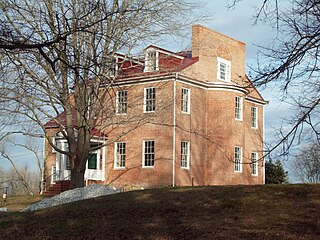
Melford is a historic plantation house located on the grounds of the Maryland Science and Technology Center, near the intersection of U.S. Route 301 and U.S. Route 50, at Bowie, Prince George's County, Maryland. The house is multi-part, gable-roofed, brick and stone dwelling house constructed probably in the mid-late 1840s, with elements of the Greek Revival style.
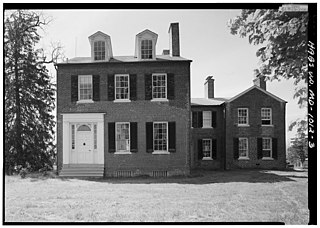
Pleasant Hills is a historic home located near Upper Marlboro in Prince George's County, Maryland, United States. It is a large, two-part brick house with Greek Revival detailing. The more recent, main block, was built in 1836 by Zaddock Sasscer.

Pleasant Prospect is a historic home located at Mitchellville, Prince George's County, Maryland. It is an outstanding and important example of a Federal style plantation house, consisting of a 2½-story main structure over a full basement with a 2-story kitchen linked by a 1-story hyphen. The kitchen wing and hyphen are typical of late eighteenth century ancillary architecture in Southern Maryland. The walls are laid in Flemish bond, and the chimneys are typical of Maryland; wide on the side, thin and high above the ridge, rising on the gable ends of the house flush with the building wall. The interior exhibits outstanding Federal style trim, including elaborate Adamesque moldings and plasterwork ornamentation such as garlands, swags, and urns applied to interior doorways and mantles. A pyramidal roof, log meat house stands on the immediate grounds.

St. Mary's Beneficial Society Hall, constructed in 1892, is a historic building located in Upper Marlboro, Prince George's County, Maryland.

Mt. Tabor Good Samaritan Lodge #59 is a historic building at Crownsville, Anne Arundel County, Maryland. It was constructed in 1899, and is a small, two-story wood-frame building, with a gable roof. A small one-story gable roof addition was made in 2000. Founded as the United Sons and Daughters of Levi Beneficial Society, No. 1 of Mount Tabor, it later joined the Independent Order of Good Samaritans and Daughters of Samaria, an African-American beneficial and temperance society for both men and women, as Mount Tabor Lodge No. 59. It is associated with the African American beneficial or benevolent society movement, and is one of six surviving African American benevolent society buildings in the state. The structure is located behind the Mt. Tabor Methodist Episcopal Church.
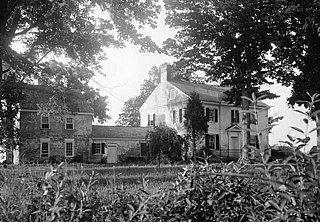
Kingston Hall is a historic home located at Kingston, Somerset County, Maryland. Located along the Big Annemessex River, it is a Georgian style dwelling of two stories plus an attic, three bays wide by two deep, connected by a one-story brick hyphen to a two-story-plus-loft brick kitchen wing. Also on the property is the brick, circular ice house. The interior of the house features corner fireplaces. Interior woodwork mouldings are in a transitional style, bridging late Georgian and Federal styles.























